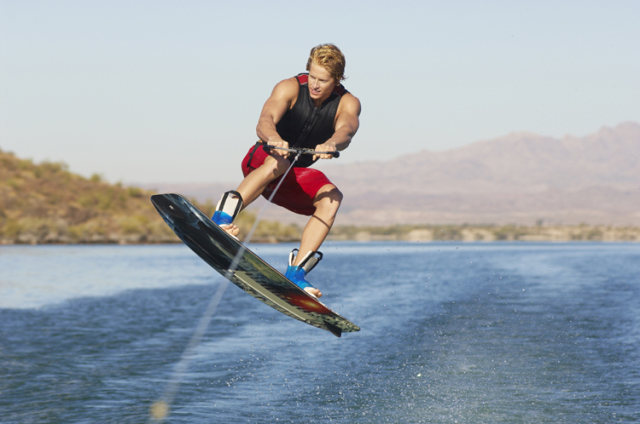Wakeboarding is a water sport in which the rider, standing on a wakeboard , is towed behind a motorboat across its wake and especially up off the crest in order to perform aerial maneuvers. A hallmark of wakeboarding is the attempted performance of midair tricks. Wakeboarding was developed from a combination of water skiing, snowboarding and surfing techniques..
The sport that would later become wakeboarding began as wakesurfing, which was invented by surfers who were looking for an alternative to surfing when the sea was calm. Wakesurfing began picking up traction around 1964, where it was seen as an exciting new sport that's soon going to sweep the waterways. Although surfboards were originally used, boards without straps or bindings were first seen in New Zealand with boards called "skurfboards". Eventually, wakeboards with bindings or straps were sold in Australia under the name McSkis.
The wakeboard rope has advanced over the years with improvements in the material makeup. When wakeboarding first started, wakeboarders used ski rope, which was made with stretchy cloth or plastic ropes. The latter soon grew in popularity, and a braided rope made out of polypropylene was eventually introduced. A few years later, a rope that was less stretchy was invented that gave the rider a more consistent pull on the rope, though they were heavier and larger in diameter. Modern ropes are coated with Spectra and Dyneema, which decrease the stretch and drag of the rope.
When wakeboarding, a wide variety of safety equipment is used. These include life vests or other buoyancy aids which prevent water-related injuries and deaths, as they keep the wearer buoyant until they are picked up. These vests especially help in situations where the rider is knocked unconscious or cannot tread water. Furthermore, wakeboarders use water-resistant helmets that are able to ventilate water so that the helmets do not fill up with water. Even the length of a wakeboarder's rope is important in providing safety; if the rope is too long, a wakeboarder will land on the flat part of the wake instead of the downside, and their knees will buckle.
When wakeboarding, a variety of tricks may be attempted. Most of these stem from the wakeboarder adjusting their posture, edge, and distribution of weight so as to fly into the air upon hitting the wake. Various tricks include the toeside edge, the heelside edge, the ride switch, and the 180° spin.

